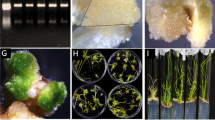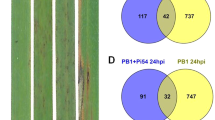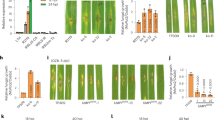Abstract
Breeding crops with resistance is an efficient way to control diseases. However, increased resistance often has a fitness penalty. Thus, simultaneously increasing disease resistance and yield potential is a challenge in crop breeding. In this study, we found that downregulation of microRNA-156 (miR-156) and overexpression of Ideal Plant Architecture1 (IPA1) and OsSPL7, two target genes of miR-156, enhanced disease resistance against bacterial blight caused by Xanthomonas oryzae pv. oryzae (Xoo), but reduced rice yield. We discovered that gibberellin signalling might be partially responsible for the disease resistance and developmental defects in IPA1 overexpressors. We then generated transgenic rice plants expressing IPA1 with the pathogen-inducible promoter of OsHEN1; these plants had both enhanced disease resistance and enhanced yield-related traits. Thus, we have identified miR-156–IPA1 as a novel regulator of the crosstalk between growth and defence, and we have established a new strategy for obtaining both high disease resistance and high yield.
This is a preview of subscription content, access via your institution
Access options
Access Nature and 54 other Nature Portfolio journals
Get Nature+, our best-value online-access subscription
$29.99 / 30 days
cancel any time
Subscribe to this journal
Receive 12 digital issues and online access to articles
$119.00 per year
only $9.92 per issue
Buy this article
- Purchase on Springer Link
- Instant access to full article PDF
Prices may be subject to local taxes which are calculated during checkout








Similar content being viewed by others
Data availability
All data generated or analysed during this study are included in this published article (and its Supplementary Information files).
Change history
16 May 2019
In the Supplementary Information file originally published with this Article, the authors mistakenly omitted accompanying legends for Supplementary Figures 1–15; this has now been amended.
References
Brown, J. K. Yield penalties of disease resistance in crops. Curr. Opin. Plant Biol. 5, 339–344 (2002).
Smakowska, E., Kong, J., Busch, W. & Belkhadir, Y. Organ-specific regulation of growth–defense tradeoffs by plants. Curr. Opin. Plant Biol. 29, 129–137 (2016).
Ning, Y., Liu, W. & Wang, G. L. Balancing immunity and yield in crop plants. Trends Plant Sci. 22, 1069–1079 (2017).
Huot, B., Yao, J., Montgomery, B. L. & He, S. Y. Growth–defense tradeoffs in plants: a balancing act to optimize fitness. Mol. Plant 7, 1267–1287 (2014).
Strange, R. N. & Scott, P. R. Plant disease: a threat to global food security. Annu. Rev. Phytopathol. 43, 83–116 (2005).
Lorrain, S., Vailleau, F., Balague, C. & Roby, D. Lesion mimic mutants: keys for deciphering cell death and defense pathways in plants? Trends Plant Sci. 8, 263–271 (2003).
Bruggeman, Q., Raynaud, C., Benhamed, M. & Delarue, M. To die or not to die? Lessons from lesion mimic mutants. Front. Plant Sci. 6, 24 (2015).
Chakraborty, J., Ghosh, P. & Das, S. Autoimmunity in plants. Planta 248, 751–767 (2018).
Brown, J. K. A cost of disease resistance: paradigm or peculiarity? Trends Genet. 19, 667–671 (2003).
Nelson, R., Wiesner-Hanks, T., Wisser, R. & Balint-Kurti, P. Navigating complexity to breed disease-resistant crops. Nat. Rev. Genet. 19, 21–33 (2018).
Jones, J. D. & Dangl, J. L. The plant immune system. Nature 444, 323–329 (2006).
Tian, D. et al. Fitness costs of R-gene-mediated resistance in Arabidopsis thaliana. Nature 423, 74–77 (2003).
Deng, Y. et al. Epigenetic regulation of antagonistic receptors confers rice blast resistance with yield balance. Science 355, 962–965 (2017).
Spoel, S. H. & Dong, X. Making sense of hormone crosstalk during plant immune responses. Cell Host Microbe 3, 348–351 (2008).
Robert-Seilaniantz, A., Grant, M. & Jones, J. D. Hormone crosstalk in plant disease and defense: more than just jasmonate–salicylate antagonism. Annu. Rev. Phytopathol. 49, 317–343 (2011).
Pieterse, C. M. et al. Hormonal modulation of plant immunity. Annu. Rev. Cell Dev. Biol. 28, 489–521 (2012).
Yang, D. L., Yang, Y. & He, Z. Roles of plant hormones and their interplay in rice immunity. Mol. Plant 6, 675–685 (2013).
Berens, M. L., Berry, H. M., Mine, A., Argueso, C. T. & Tsuda, K. Evolution of hormone signaling networks in plant defense. Annu. Rev. Phytopathol. 55, 401–425 (2017).
Wang, D. et al. Salicylic acid inhibits pathogen growth in plants through repression of the auxin signaling pathway. Curr. Biol. 17, 1784–1790 (2007).
Ding, X. et al. Activation of the indole-3-acetic acid-amido synthetase GH3-8 suppresses expansin expression and promotes salicylate- and jasmonate-independent basal immunity in rice. Plant Cell 20, 228–240 (2008).
Li, X. et al. The systemic acquired resistance regulator OsNPR1 attenuates growth by repressing auxin signaling through promoting IAA-amido synthase expression. Plant Physiol. 172, 546–558 (2016).
Kazan, K. & Manners, J. M. Linking development to defense: auxin in plant–pathogen interactions. Trends Plant Sci. 14, 373–382 (2009).
Hou, X., Lee, L. Y., Xia, K., Yan, Y. & Yu, H. DELLAs modulate jasmonate signaling via competitive binding to JAZs. Dev. Cell 19, 884–894 (2010).
Yang, D. L. et al. Plant hormone jasmonate prioritizes defense over growth by interfering with gibberellin signaling cascade. Proc. Natl Acad. Sci. USA 109, E1192–E1200 (2012).
Li, W. et al. A natural allele of a transcription factor in rice confers broad-spectrum blast resistance. Cell 170, 114–126 (2017).
Xu, G. et al. uORF-mediated translation allows engineered plant disease resistance without fitness costs. Nature 545, 491–494 (2017).
Fu, D. et al. A kinase-START gene confers temperature-dependent resistance to wheat stripe rust. Science 323, 1357–1360 (2009).
Krattinger, S. G. et al. A putative ABC transporter confers durable resistance to multiple fungal pathogens in wheat. Science 323, 1360–1363 (2009).
Sasaki, A. et al. Green revolution: a mutant gibberellin-synthesis gene in rice. Nature 416, 701–702 (2002).
Spielmeyer, W., Ellis, M. H. & Chandler, P. M. Semidwarf (sd-1), “green revolution” rice, contains a defective gibberellin 20-oxidase gene. Proc. Natl Acad. Sci. USA 99, 9043–9048 (2002).
Liu, C. et al. Shortened basal internodes encodes a gibberellin 2-oxidase and contributes to lodging resistance in rice. Mol. Plant 11, 288–299 (2018).
Yang, D. L. et al. Altered disease development in the eui mutants and Eui overexpressors indicates that gibberellins negatively regulate rice basal disease resistance. Mol. Plant 1, 528–537 (2008).
Qin, X. et al. Gibberellin 20-oxidase gene OsGA20ox3 regulates plant stature and disease development in rice. Mol. Plant Microbe Interact. 26, 227–239 (2013).
De, Vleesschauwer, D. et al. The DELLA protein SLR1 integrates and amplifies salicylic acid- and jasmonic acid-dependent innate immunity in rice. Plant Physiol. 170, 1831–1847 (2016).
Wang, J. W., Czech, B. & Weigel, D. miR156-regulated SPL transcription factors define an endogenous flowering pathway in Arabidopsis thaliana. Cell 138, 738–749 (2009).
Wu, G. et al. The sequential action of miR156 and miR172 regulates developmental timing in Arabidopsis. Cell 138, 750–759 (2009).
Yu, N. et al. Temporal control of trichome distribution by microRNA156-targeted SPL genes in Arabidopsis thaliana. Plant Cell 22, 2322–2335 (2010).
Xing, S. et al. miR156-targeted and nontargeted SBP-box transcription factors act in concert to secure male fertility in Arabidopsis. Plant Cell 22, 3935–3950 (2010).
Yu, S. et al. Gibberellin regulates the Arabidopsis floral transition through miR156-targeted SQUAMOSA promoter binding-like transcription factors. Plant Cell 24, 3320–3332 (2012).
Xu, M. et al. Developmental functions of miR156-regulated SQUAMOSA promoter binding protein-like (SPL) genes in Arabidopsis thaliana. PLoS Genet. 12, e1006263 (2016).
Jiao, Y. et al. Regulation of OsSPL14 by OsmiR156 defines ideal plant architecture in rice. Nat. Genet. 42, 541–544 (2010).
Miura, K. et al. OsSPL14 promotes panicle branching and higher grain productivity in rice. Nat. Genet. 42, 545–549 (2010).
Zhang, L. et al. A natural tandem array alleviates epigenetic repression of IPA1 and leads to superior yielding rice. Nat. Commun. 8, 14789 (2017).
Li, Y. et al. Multiple rice microRNAs are involved in immunity against the blast fungus Magnaporthe oryzae. Plant Physiol. 164, 1077–1092 (2014).
Dai, Z. et al. Modulation of plant architecture by the miR156f–OsSPL7–OsGH3.8 pathway in rice. J. Exp. Bot. 69, 5117–5130 (2018).
Wang, J. et al. A single transcription factor promotes both yield and immunity in rice. Science 361, 1026–1028 (2018).
Xie, K., Wu, C. & Xiong, L. Genomic organization, differential expression, and interaction of SQUAMOSA promoter-binding-like transcription factors and microRNA156 in rice. Plant Physiol. 142, 280–293 (2006).
Ueguchi-Tanaka, M. et al. Molecular interactions of a soluble gibberellin receptor, GID1, with a rice DELLA protein, SLR1, and gibberellin. Plant Cell 19, 2140–2155 (2007).
Hirano, K. et al. Characterization of the molecular mechanism underlying gibberellin perception complex formation in rice. Plant Cell 22, 2680–2696 (2010).
Zhu, Y. et al. Elongated uppermost internode encodes a cytochrome P450 monooxygenase that epoxidizes gibberellins in a novel deactivation reaction in rice. Plant Cell 18, 442–456 (2006).
Luo, A. et al. EUI1, encoding a putative cytochrome P450 monooxygenase, regulates internode elongation by modulating gibberellin responses in rice. Plant Cell Physiol. 47, 181–191 (2006).
Lu, Z. et al. Genome-wide binding analysis of the transcription activator ideal plant architecture1 reveals a complex network regulating rice plant architecture. Plant Cell 25, 3743–3759 (2013).
Moscou, M. J. & Bogdanove, A. J. A simple cipher governs DNA recognition by TAL effectors. Science 326, 1501 (2009).
Weiberg, A., Wang, M., Bellinger, M. & Jin, H. Small RNAs: a new paradigm in plant–microbe interactions. Annu. Rev. Phytopathol. 52, 495–516 (2014).
Cai, Q., He, B., Kogel, K. H. & Jin, H. Cross-kingdom RNA trafficking and environmental RNAi—nature’s blueprint for modern crop protection strategies. Curr. Opin. Microbiol. 46, 58–64 (2018).
Navarro, L. et al. A plant miRNA contributes to antibacterial resistance by repressing auxin signaling. Science 312, 436–439 (2006).
Wang, Z. et al. Osa-miR164a targets OsNAC60 and negatively regulates rice immunity against the blast fungus Magnaporthe oryzae. Plant J. 95, 584–597 (2018).
Wang, S. et al. Control of grain size, shape and quality by OsSPL16 in rice. Nat. Genet. 44, 950–954 (2012).
Peng, J. et al. ‘Green revolution’ genes encode mutant gibberellin response modulators. Nature 400, 256–261 (1999).
Mao, Y. B. et al. Jasmonate response decay and defense metabolite accumulation contributes to age-regulated dynamics of plant insect resistance. Nat. Commun. 8, 13925 (2017).
Zhang, Y. et al. Gibberellin homeostasis and plant height control by EUI and a role for gibberellin in root gravity responses in rice. Cell Res. 18, 412–421 (2008).
Chen, H. et al. Firefly luciferase complementation imaging assay for protein–protein interactions in plants. Plant Physiol. 146, 368–376 (2008).
Waadt, R. et al. Multicolor bimolecular fluorescence complementation reveals simultaneous formation of alternative CBL/CIPK complexes in planta. Plant J. 56, 505–516 (2008).
Zhou, F. et al. D14–SCFD3-dependent degradation of D53 regulates strigolactone signalling. Nature 504, 406–410 (2013).
Ma, X. et al. CHR729 is a CHD3 protein that controls seedling development in rice. PLoS ONE 10, e0138934 (2015).
Acknowledgements
This work was supported by the National Key Research and Development Program of China (2016YFD0100600), the Natural Science Foundation of Jiangsu (BK20170027 and BK20150659), the National Key Transformation Program (2016ZX08001002), the Fundamental Research Funds for the Central Universities (KYZ201503, KJJQ201801 and KYZ201812), the National Natural Science Foundation of China (31671340), the Innovative Project of State Key Laboratory of Crop Genetics and Germplasm Enhancement (ZZ2017009), and Jiangsu Collaborative Innovation Center for Modern Crop Production to D.-L.Y.
Author information
Authors and Affiliations
Contributions
M.L. conducted most of the experiments. Z.S. generated the MIM156, miR-156-OE and OsSPL7-OE transgenic plants. X.Z. and M.W. contributed to disease analysis. L.Z. generated the IPA1-OE transgenic rice plants. K.Z. and J.L. characterized the morphological phenotypes. C.D. generated the SLR1 antibody. X.H., Q.Q. and Z.H. contributed analysis reagents. D.-L.Y. designed the experiments and wrote the manuscript. All authors discussed the data and contributed to the manuscript.
Corresponding author
Ethics declarations
Competing interests
Based on the results in this study, the authors have applied for patents (application no. 201811001480.8 and 201811002033.4).
Additional information
Journal peer review information: Nature Plants thanks Beat Keller and Mingliang Xu for their contribution to the peer review of this work.
Publisher’s note: Springer Nature remains neutral with regard to jurisdictional claims in published maps and institutional affiliations.
Supplementary information
Supplementary Information
Supplementary Figures 1–15.
Supplementary Table 1
Supplementary Table 1.
Rights and permissions
About this article
Cite this article
Liu, M., Shi, Z., Zhang, X. et al. Inducible overexpression of Ideal Plant Architecture1 improves both yield and disease resistance in rice. Nat. Plants 5, 389–400 (2019). https://doi.org/10.1038/s41477-019-0383-2
Received:
Accepted:
Published:
Issue Date:
DOI: https://doi.org/10.1038/s41477-019-0383-2
This article is cited by
-
Switching action modes of miR408-5p mediates auxin signaling in rice
Nature Communications (2024)
-
OsMAPK6 positively regulates rice cold tolerance at seedling stage via phosphorylating and stabilizing OsICE1 and OsIPA1
Theoretical and Applied Genetics (2024)
-
Genetic and functional mechanisms of yield-related genes in rice
Acta Physiologiae Plantarum (2024)
-
Xoo-responsive transcriptome reveals the role of the circular RNA133 in disease resistance by regulating expression of OsARAB in rice
Phytopathology Research (2023)
-
IPA1 improves drought tolerance by activating SNAC1 in rice
BMC Plant Biology (2023)



